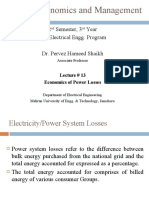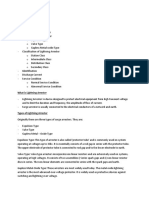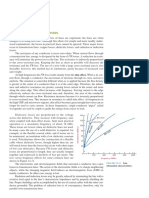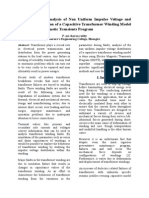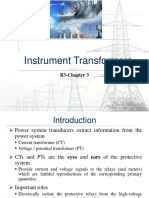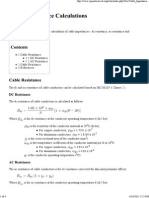Power Losses in Wound Components
Power Losses in Wound Components
Uploaded by
shankar_sai_1Copyright:
Available Formats
Power Losses in Wound Components
Power Losses in Wound Components
Uploaded by
shankar_sai_1Original Title
Copyright
Available Formats
Share this document
Did you find this document useful?
Is this content inappropriate?
Copyright:
Available Formats
Power Losses in Wound Components
Power Losses in Wound Components
Uploaded by
shankar_sai_1Copyright:
Available Formats
Power losses in wound components
Page 1 of 13
Power losses in wound components
Outlined here are the various causes of inefficiency, methods of estimating them and techniques for minimizing them. Your life as a designer of transformers, for example, would be far simpler if you did not need to worry about power losses; you would simply select a part having the turns ratio needed - and that would be that. It's the requirements to keep the losses under control that largely determines whether your transformer weighs one gram and costs one dollar or weighs one ton and costs ten thousand dollars. Power is lost in an inductor through several different mechanisms: 1. 2. 3. 4. 5. 6. Resistance of the windings - 'copper loss'. Magnetic friction in the core - 'hysteresis'. Electric currents induced in the core - 'eddy currents'. Physical vibration and noise of the core and windings. Electromagnetic radiation. Dielectric loss in materials used to insulate the core and windings.
Only the first of these, the copper loss, operates even when the current in the winding is not changing. The other losses all fall to zero with frequency. Hysteresis and eddy current losses are collectively known as iron loss or core loss (even if a ferrite core is used). The figures for common core materials are tabulated in Kaye & Laby. About your browser: if this character '' does not look like a multiplication sign, or you see lots of question marks '?' or symbols like ' ' or sequences like '&cannot;' then please accept my apologies. See also ... [ Producing wound components] [A guide to the terminology used in the science of magnetism] [ Air coils] [The force produced by a magnetic field] [ Faraday's law] [Guide to unit systems in electromagnetism] [ AWG explained]
Copper losses
Copper loss or winding loss is the term used to describe the energy dissipated by resistance in the wire used to wind a coil.
http://info.ee.surrey.ac.uk/Workshop/advice/coils/power_loss.html
12/23/2011
Power losses in wound components
Page 2 of 13
Current density
Quantity name Current density Quantity symbol J Unit name amperes per metre squared Unit symbols A m-2 Current density in the SI The question of current density is a critical one for the designer of wound components. It appears in formulae which relate the gauge of wire needed to the size of coil former required to hold the wire. In simplistic terms, a high value for J leads to compact, cheap and inefficient inductors, whilst a low value implies bulky, expensive, more efficient and, possibly, more reliable designs. Generally J=I/A Equation PLH
where A is the cross sectional area, in metres squared, of some part of the winding and I the total current flow, in amperes, in that area. In data sheets the value will often be quoted in amps per square millimetre. In that case you will neeed to multiply by 106 before substitution in the formulae given here. In these pages you will meet two kinds of current density. The first is what you might term the 'raw' current desnsity: JC. Here the area under consideration is AC: exactly that part of the cross section of one of the turns which is composed entirely of copper conductor. Surrounding insulation space is ignored. For small transformers the value of this density will be in the order of 3.5 A mm-2. The second variation is JW where the area considered, AW, is the entire winding aperture of the coil former - including insulation around the wire itself, air between the wires and any tape used to separate one layer of turns from the one above. JW will be considereably lower than JC. The (dimensionless) ratio of these two is the winding copper factor, FW FW = JW / JC = N AC / AW Equation PLI
where AC is the the cross sectional area of the copper in a single turn. Practical values of FW for the type of inductors most used in electronics will be about 0.5. In other words, only about half the winding space will be filled with copper. [ Top of page]
Wire gauges
In most cases your wire will be made of copper, whose resistivity at 20 C is about 1.7310-8 ohm metres. Real world coils often operate above room temperature. You can then multiply by a 'fiddle factor', m:
http://info.ee.surrey.ac.uk/Workshop/advice/coils/power_loss.html
12/23/2011
Power losses in wound components
Page 3 of 13
Temperature (C) 20 40 60 80 100 m (Mullard, 1979) 1.0 1.079 1.157 1.236 1.314 You can conveniently estimate the resistance of a wire as R = 0.022 / DW2 ohms per metre where DW is the diameter of the conductor in millimetres. Usually, you will know the length of a winding from lw = N Dav metres where N is the number of turns and Dav is the average diameter of the winding in metres. Your copper losses will then be PW = 0.022 lw (I / DW)2 watts where I is the RMS current in the winding. The usual range of current densities seen in power transformers lies between about 1.5 to 5 amps per square millimetre. A good starting point is 3.5A mm-2. AWG Diameter Current Wire / mm /A Gauge 0 8.25E+00 1.87E+02 2 6.54E+00 1.18E+02 4 5.19E+00 7.40E+01 6 4.11E+00 4.65E+01 8 3.26E+00 2.93E+01 10 2.59E+00 1.84E+01 12 2.05E+00 1.16E+01 14 1.63E+00 7.28E+00 16 1.29E+00 4.58E+00 18 1.02E+00 2.88E+00 20 8.12E-01 1.81E+00 22 6.44E-01 1.14E+00 24 5.11E-01 7.17E-01 26 4.05E-01 4.51E-01 28 3.21E-01 2.83E-01 30 2.55E-01 1.78E-01 32 2.02E-01 1.12E-01 34 1.60E-01 7.05E-02 36 1.27E-01 4.43E-02 Equation PLA
Resitivity(20C)/ m 10-8 Aluminium 2.65 Copper 1.73 Graphite 1375 (0C) Iron (pure) 10 Iron (3% Si) 47 Silver 1.59 Material
Table RST: Approximate resistivities of common materials
BS Diameter Current Wire Gauge / mm /A 10 3.24 2.9E+01 12 2.64 1.9E+01 14 2.03 1.1E+01 16 1.62 7.2E+00 18 1.22 4.1E+00 20 0.91 2.3E+00 22 0.71 1.4E+00 24 0.56 8.6E-01 26 0.46 5.8E-01 28 0.376 3.9E-01 30 0.304 2.5E-01 32 0.274 2.1E-01 34 0.234 1.5E-01 36 0.193 1.0E-01 38 0.152 6.4E-02 40 0.122 4.1E-02 42 0.102 2.9E-02 44 0.081 1.8E-02
http://info.ee.surrey.ac.uk/Workshop/advice/coils/power_loss.html
12/23/2011
Power losses in wound components
Page 4 of 13
38 40
1.01E-01 2.79E-02 7.99E-02 1.75E-02
Table PLY: Current capacities at 3.5 A mm-2
Table PLA: Current capacities at 3.5 A mm-2
You can look up the diameter corresponding to this density in table PLA. If efficiency, long life for the insulation and good voltage regulation are important then choose a lower current density. If size, weight, cost or frequency range are important then choose a higher density. Unfortunately the above analysis holds only for low frequencies. Copper losses increase with frequency due to the skin effect.
Skin effect
Skin effect refers to the tendency of current flow in a conductor to be confined to a layer in the conductor close to its outer surface. At low frequencies the skin effect is negligible and the distribution of current across the conductor is uniform. As frequency is increased the depth to which the flow can penetrate, DS / metres, is reduced. DS = (107/(r f)) / (2) Equation PSE
where is the conductor resistivity (ohm metres), r is the relative permeability and f is the frequency (Hz). 50Hz 1kHz 100kHz 1MHz 10MHz Copper 9.36E-03 2.09E-03 2.09E-04 6.62E-05 2.09E-05 Aluminium 1.16E-02 2.59E-03 2.59E-04 8.19E-05 2.59E-05 Iron (3% Si) 2.82E-03 6.30E-04 6.30E-05 1.99E-05 6.30E-06 r=300 Graphite 2.64E-01 5.90E-02 5.90E-03 1.87E-03 5.90E-04
Skin depth / m
Skin effect causes the apparent resistance of a coil to increase above that suggested by the DC value, thus lowering the Q-factor in resonant circuits and reducing the efficiency in switching supplies. Skin effect occurs because current flow moves away from those regions of the conductor having the strongest magnetic field. A consequence of this is that the number of flux linkages between turns will be reduced. Therefore skin effect produces a decrease in inductance; of about 2%, though more if the wire is short. Having chosen a diameter of wire that can cope with the current at zero Hz you should check that skin effect is not going to be a problem at the frequency at which you actually need to work. The formula below (Terman) gives the diameter of wire that will suffer a 10% increase in resistance at the frequency of operation, f (in Hz) DW = 200 / f millimetres
http://info.ee.surrey.ac.uk/Workshop/advice/coils/power_loss.html
12/23/2011
Power losses in wound components
Page 5 of 13
This formula applies for isolated conductors. In a coil surrounded by other turns the actual resistance will be higher because of the proximity effect. Taking the example of a coil working at 10 kHz you will see that a wire diameter of 2 mm is about as thick as you can go without skin effect increasing its AC resistance. Incidentally, if you are designing a switch mode supply don't forget to take harmonics of the switching frequency into account. If you find that the diameter determined for zero Hz is greater than the diameter at which skin effect will take place at your operating frequency then what options do you have? Ignore the problem. Perhaps efficiency is not crucial to your design and you can tolerate a coil that runs hot. Use the diameter of wire as calculated above but wind more than one of them on simultaneously. Use thicker wire and accept that the interior of the wire will not contribute to conduction. The resistance of the wire at high frequencies then falls with the reciprocal of the diameter and not the square of the diameter as it does at zero Hz. The current flows only in a thin 'skin' near the surface of the wire. This is the normal approach above about 1 MHz. R = 8.32 10-5 f / DW ohms per metre Where f is frequency (Hz), and DW the wire diameter (millimeters). Use genuine Litz wire. [ Top of page]
Litz wire
Litz (a contraction of Litzendraht) wire consists of thin strands of enamel insulated wire held together by an outer covering of silk or cotton. There will usually be at least 5 strands but perhaps as many as 1000 or more. Its purpose is to minimize the resistive losses that arise at high frequencies due to skin effect. Litz wire is mostly used within the frequency range 10kHz to 1MHz. Because it is expensive and difficult to obtain you should usually only consider this type of wire if you are certain that the increased performance is essential. A typical application is long wave rod antennas. A more detailed paper analyzing the skin and proximity effects in litz wire is available at Dartmouth College. [ Top of page]
http://info.ee.surrey.ac.uk/Workshop/advice/coils/power_loss.html
12/23/2011
Power losses in wound components
Page 6 of 13
Q factor
The Q factor of a coil is important when it is used in a resonant circuit because it affects the 'sharpness' of the response curve.
The Q or quality factor of a resonant circuit is a measure of the ratio of the energy stored in it to the energy lost during one cycle of operation. All practical inductors exhibit losses due to the resistance of the wire or absorption by materials within the magnetic field surrounding it. It is possible to model these losses as a resistance, R, in series with a perfect or loss free inductance L.
The value of R will be greater than that of the DC resistance of the wire due to skin effect. The above formula suggests that the Q of any given inductor will increase indefinitely with frequency. This is never the case because of an effect known as self resonance. Practical values of Q range from around 10 for a high loss circuit through about 100 for a reasonable one up to around 1000 with careful design and favourable conditions. Modern ferrite materials have low hysteresis and eddy current losses but they can still be significant. Cores with an air gap are needed to achieve the highest Q factor and temperature stability. [ Top of page]
Coercivity
coercivity, alias coercive force Quantity symbol Hc Unit name ampere per metre Unit symbols A m-1 Coercivity in the SI Quantity name
http://info.ee.surrey.ac.uk/Workshop/advice/coils/power_loss.html
12/23/2011
Power losses in wound components
Page 7 of 13
Coercivity occurs within ferromagnetic materials and is the field strength which must be applied in order to reduce (or coerce) a remnant flux to zero. Materials with high coercivity (such as those used for permanent magnets) are sometimes called hard. A good example of a hard material is Alnico, which may have an Hc of about 80,000 A m-1. Conversely, materials with low coercivity (such as those used for transformers) are called soft. Supermalloy has an Hc of about 0.5 A m-1. Those materials with a low coercivity tend to have a high permeabilty and vice versa. See the paragraph on hysteresis for more details. [ Top of page]
Remnance
Quantity name remnance, alias remanence
or residual induction
Quantity symbol Br Unit name tesla Unit symbol T Base units kg s-2 A-1 Remnance in the SI Remnance (or remanence) occurs within ferromagnetic materials and is the flux density which remains in a magnetic material when any externally applied field is removed (H = 0). For materials used in permanent magnets you usually need a high value of remnance. For transformers you need low remnance. See the paragraph on hysteresis for more details. Remnance is also what makes possible all magnetic recording technologies; including the hard disk drive on which this text was stored until you loaded it into your browser. [ Top of page]
Hysteresis loss
Figure PHY shows the effect within ferromagnetic materials known as hysteresis.
http://info.ee.surrey.ac.uk/Workshop/advice/coils/power_loss.html
12/23/2011
Power losses in wound components
Page 8 of 13
We start with an unmagnetized sample at the origin (P1) where both field strength and flux density are zero. The field strength is increased in the positive direction and the flux begins to grow along the dotted path until we reach P2. This is called the initial magnetization curve. If the field strength is now relaxed then some curious behavior occurs. Instead of retracing the initial magnetization curve the flux falls more slowly. In fact, even when the applied field is returned to zero there will still be a remaining (remnant or remanent) flux density at P3. It is this phenomenon which makes permanent magnets possible. To force the flux to go back to zero we have to reverse the applied field (P4). The field strength here is called the coercivity. We can then continue reversing the field to get to P5, and so on round this type of magnetization curve called (by J. A. Ewing) a hysteresis loop. What is the significance of this from the point of power losses? It is that we have had to expend energy in order to set up the remnant flux. To show this more clearly we'll look at separate figures below. The area (shown shaded) between the B-H curve and the B axis represents the work done (per unit volume of material).
W = 0BH dB
J m-3
You can see that the energy required to 'pump up' the core by moving from P1 to P2 is more than that which it returns when going from P2 to P3. This is evocatively termed inelastic behavior. You could look at this another way by thinking about the 'back emf' which opposed the initial increase in coil current. The emf generated is always proportional to the change in flux; but the flux changes less on the 'way down' than it does going up. We can go a stage further and deduce that the total power lost over one complete cycle is proportional to the area within the hysteresis loop. Because this effect is related to an area, hysteresis loss is roughly proportional to the square of the working flux density. In fact, the non-linearities will, for transformer iron, reduce this to about B1.6. The particular value for a given material is called the Steinmetz exponent, n. Unfortunately, it is very rare to see a data sheet which states n directly. For an
http://info.ee.surrey.ac.uk/Workshop/advice/coils/power_loss.html
12/23/2011
Power losses in wound components
Page 9 of 13
iron core device it is sometimes assumed to be 1.6. For ferrite grade 3C8 it is 2.5. Data sheets sometimes have graphs of loss versus flux density on a log scale. These can be used to estimate n. Because a hysteresis loss is incurred each time the core cycles, from positive to negative values of B, the loss rate (watts) is directly proportional to the frequency of operation, f (Hz). We can combine these proportionalities in a single formula for the hysteresis loss: Ph = KhfBn watts m-3 Where Kh also depends on the particular core material. Significantly, hysteresis loss in a transformer is essentially independent of load current; it depends just on flux and hence voltage. Consequently the efficiency of a transformer drops towards zero with the load current. You can build a simple circuit to display hysteresis. By the way, this tells us why it really isn't advisable to subject a transformer to a voltage (and hence flux) overload - it's going to get hot before you go very far :-(
Hard and soft magnetic materials
The hysteresis of a material strongly affects its suitability for a particular application.
The left hand curve shows a 'soft' magnetic material such as iron alloyed with silicon. Its area is small so it's ideal for a low loss transformer core. The addition of 3 % of silicon to iron reduces the hysteresis loss at 1 tesla from about 250 to 163 J m-3. The material on the right hand curve is 'hard' magnetic. Its large area is commonly seen in materials such as Alnico (an iron/cobalt/nickel/aluminium alloy) used for permanent magnets. A word of warning about the terms 'hard' and 'soft': many writers use it to denote only that the value of coercive force is high or low respectively. Others use them to say that the shape of the loop is 'wide' or 'thin'. That is ambiguous. Does it just refer to Hc or to the ratio of Hc to Br? Other writers say that hard or soft means the area of the loop is large or small. Yet others (e.g. Duffin) use hard or soft to denote the value of the remnant field! Groan :-( In practise, high Hc often goes together with high Br and everyone is happy. If you want a winner then go for straight coercivity. Hard means Hc above 10 kAm-1. Soft means Hc below 1 kAm-1. [ Top of page]
http://info.ee.surrey.ac.uk/Workshop/advice/coils/power_loss.html
12/23/2011
Power losses in wound components
Page 10 of 13
Eddy current loss
Eddy current losses occur whenever the core material is electrically conductive. Most ferromagnetic materials contain iron: a metal that has fairly low resistivity (roughly 10-7 m). The problem is intuitively obvious if you consider that the magnetic field is contained within a 'circuit' or loop formed by the periphery of the core in the same way as it is contained within a turn on the windings. Around that periphery a current will be induced in the same way as it is in an ordinary turn which is shorted at its ends. What is needed, then, is some method of increasing the resistance of the core to current flow without inhibiting the flow of magnetic flux. In mains transformers this is achieved by alloying the iron with about 3% of silicon. This lifts the resistivity to 4.510-7 m. Depending upon the amount of silicon this material is called 'transformer iron', 'electrical iron' or 'armature iron'. The alternative name 'silicon steel' is a misnomer because steel is iron alloyed with carbon; and carbon does no good in a transformer core. The silicon does, though, increase the mechanical hardness of iron in the same way as carbon - try sawing up a transformer core and you'll discover this quickly. In any resistive circuit the power is proportional to the square of the applied voltage. The induced voltage is itself proportional to fB and so the eddy losses are proportional to f2B2. The flux is also related to the size of the loop. Figure PLM shows how the idea of lamination is used to reduce the power losses caused by eddy currents in mains transformers. The same principle applies to motors and generators too. Using a solid iron core (as in cross-section B) results in a large circulating current. So, instead, the core is made up of a stack of thin (~0.5 millimetre) sheets (cross section C). Here I have shown only four laminations but there will normally be many more. The lines of magnetic flux can still run around the core within the plane of the laminations. The situation for the eddy currents is different. The surface of each sheet carries an insulating oxide layer formed during heat treatment. This prevents current from circulating from one lamination across to its neighbors. Clearly, the current in each lamination will be less than the very large current we had with the solid core; but there are more of these small currents. So have we really won? The answer is yes, for two reasons. Power loss (the reduction of which is our aim) is proportional to the square of induced voltage. Induced voltage is proportional to the rate of change of flux, and each of our laminations carries one quarter of the flux. So, if the voltage in each of our four laminations is one quarter of what it was in the solid core then the power dissipated in each lamination is one sixteenth the previous value. Hurrah!
http://info.ee.surrey.ac.uk/Workshop/advice/coils/power_loss.html
12/23/2011
Power losses in wound components
Page 11 of 13
But wait; it gets better. Look at the long thin path that the eddy current takes to travel round the lamination. Suppose we made the laminations twice as thin (we halved d1). The path length of the current isn't much changed; it's still about 2d2. However, the width of the path has halved and therefore its resistance will double and so the current will be halved. The bottom line is that eddy current loss is inversely proportional to the square of the number of laminations. Iron losses should be between about 1 and eight watts per kilogram at 50Hz and 1.5T for good transformer steel. This idea of dividing up the iron into thin sections is carried a stage further in the iron dust cores. Here the iron is ground into a powder, mixed with some insulating binder or matrix material and then fired to produce whatever shape of core is required. These cores can function at several megahertz but their permeability is lower than solid iron. [ Top of page]
Transformer size vs power rating
In general, the cross sectional area of a transformer core, Ae, determines how much flux the core can carry and therefore how much voltage is induced in each turn. The cross sectional area of the winding aperture, Aw, determines how thick the wire can be and therefore how much current it can handle. From these you can estimate the VA rating. The peak core flux is pk = Bpk Ae webers Equation PLG
For most laminated iron cores Bpk is kept below about 1.2 teslas. The transformer equation relates this flux to induced RMS voltage V = 4.44 N f pk volts Equation PLB
where N is the number of turns on the primary and f is the frequency of operation in hertz. Now, what about the current capacity of the primary? Unfortunately, the raw figure for the area of the primary winding aperture isn't directly useful here because, in a practical coil, much of this area is occupied not by copper (which can carry current) but by insulation and other gaps (which can't) between the turns. We represent this difference by a parameter called the winding factor or the space utilization factor, Fw ACu = Aw Fw m2 Equation PLC
Where ACu is the cross sectional area of actual copper. For many designs Fw is about 0.5. That is, half of the primary cross section is actually copper.
http://info.ee.surrey.ac.uk/Workshop/advice/coils/power_loss.html
12/23/2011
Power losses in wound components
Page 12 of 13
Even less certain is the working current density in the wire, j. This is about 3 amps per millimetre squared (3106 A m-2) for most small mains transformers. Whatever value is pulled out of the hat for j you then get the winding current by I = j ACu / N amps Putting this together V I = 4.44 j ACu f pk volt-amps Equation PLE Equation PLD
Take as an example the 50 VA transformer kit from RS, stock no. 182-9919, working at 50 Hz. This has a rectangular section central core for the lamination stack 28 x 43 mm so Ae = 1.1610-3 m2 and so pk = 1.2 1.1610-3 = 1.3910-3 weber. The primary winding is 37.5 mm high by 3 mm deep so Aw = 1.1310-4 m2, giving an ACu = 0.5 1.1310-4 = 5.6310-5 m2. V I = 4.44 3106 50 5.6310-5 1.3910-3 = 52 volt-amps Equation PLF This is a closer result than you will normally get. Fundamentally, the rate at which a transformer looses heat depends upon its surface area - which increases in proportion to the square of the transformer's linear dimension. How fast heat is generated inside a transformer depends upon the volume of iron and copper - which increases as the cube of the linear dimension. Large transformers tend to be run at lower flux and current ratings which improves efficiency (99% is common). This is partly for reasons of cost savings through reduced energy wastage but they also have to be more efficient than small transformers because they have a harder job getting rid of heat. This explains why the largest transformers are fitted with oil-filled cooling loops: they effectively increase surface area. [ Top of page]
Balancing copper and iron losses
By various means, such as the use of air gaps, or by selecting a lower permeability material, it's possible to trade off copper losses against iron losses. This raises the question of how this should be done to obtain the most efficient operation. The answer, as described by Jansson, is succinct: PW = nPC / 2 where PW is the copper loss, PC is the iron loss and n is the Steinmetz exponent for the core material.
http://info.ee.surrey.ac.uk/Workshop/advice/coils/power_loss.html
12/23/2011
Power losses in wound components
Page 13 of 13
It is also useful during the design of a transformer to be able to relate the power losses (PL in watts) to its temperature rise (T in C). Some data sheets will give this but, if not, then this empirical formula (SEI Ltd.) should give an indication at least. AS = 10-4(59(1000/(TA+273))1.69 (PL0.82 /T))1.22 m2 Equation PTR
Where AS is the exposed surface area of the core (metres squared), and TA is the ambient temperature (C). For example, if the ambient is 25C, the total power loss is 13.7 watts and the temperature rise is 58 C then an area of 1.710-2 m2 is required. One manufacturer of the FX3750 core quotes this as its area when fully wound, but says that only 9 watts are required to give this temperature rise in free air. Discrepancies of this magnitude must be expected. [ Top of page]
E-mail: R.Clarke@surrey.ac.uk Last revised: 2008 August 2nd.
http://info.ee.surrey.ac.uk/Workshop/advice/coils/power_loss.html
12/23/2011
You might also like
- Dueñas General Comprehensive High School 1 Learning Action Cell (LAC) Session Minutes of The MeetingDocument12 pagesDueñas General Comprehensive High School 1 Learning Action Cell (LAC) Session Minutes of The MeetingLawrence Mae Asong Pamotillo II100% (13)
- Power System Loss Analysis-EngDocument5 pagesPower System Loss Analysis-EngRatana KemNo ratings yet
- Jaroslav Sasel - Trajan's Canal at The Iron GateDocument8 pagesJaroslav Sasel - Trajan's Canal at The Iron GateLuciusQuietusNo ratings yet
- Sap Charm: (Solution Manager 7.2)Document17 pagesSap Charm: (Solution Manager 7.2)Krishna Vamshi50% (2)
- History and Philosophy of EducationDocument17 pagesHistory and Philosophy of EducationFelipe Ortego60% (5)
- Power System Loss MinimisationDocument31 pagesPower System Loss MinimisationBnr GoudNo ratings yet
- Electric Power Transmission and Distribution Losses Overview and Minimization in Pakistan PDFDocument5 pagesElectric Power Transmission and Distribution Losses Overview and Minimization in Pakistan PDFRamshaNo ratings yet
- Line LossesDocument5 pagesLine LossesMicron MegaNo ratings yet
- Total Losses in Power Distribution and Transmission Lines 1Document7 pagesTotal Losses in Power Distribution and Transmission Lines 1mohannad87No ratings yet
- Transmission Line Balanced Inductive Plasma Source LMBDA RESONATOR G VinogradovDocument13 pagesTransmission Line Balanced Inductive Plasma Source LMBDA RESONATOR G VinogradovPeter-sagami100% (1)
- Problems of Circuit InterruptionDocument20 pagesProblems of Circuit Interruptioneeng812450% (2)
- Total Losses in Power Distribution and Transmission Lines 1Document6 pagesTotal Losses in Power Distribution and Transmission Lines 1Muahmmad ShahzadNo ratings yet
- Lect-13 Economics of Power LossesDocument22 pagesLect-13 Economics of Power LossesAnas SheikhNo ratings yet
- Lightning ArresterDocument13 pagesLightning ArresterSubhransu MohapatraNo ratings yet
- Short Circuit CalculationsDocument15 pagesShort Circuit CalculationsJessica RibeiroNo ratings yet
- Transmission Line LossesDocument1 pageTransmission Line LossesLG TVNo ratings yet
- Types of Faults in Electrical Power Systems and Their EffectsDocument20 pagesTypes of Faults in Electrical Power Systems and Their Effectstebelayhabitamu12No ratings yet
- Power Loss CalculationDocument7 pagesPower Loss CalculationDivya PagidimarriNo ratings yet
- Line Parameters ComputationDocument4 pagesLine Parameters Computationswathi_grenNo ratings yet
- Protection of Transmission LineDocument31 pagesProtection of Transmission LineEE166Srushti Vibhute.No ratings yet
- Power Loss in Switching MOSFETsDocument6 pagesPower Loss in Switching MOSFETsManju RajagopalNo ratings yet
- Lighting Arrester - Electrical Notes & ArticlesDocument14 pagesLighting Arrester - Electrical Notes & Articlesbramhanand vermaNo ratings yet
- Power Transformer Construction WindingsDocument5 pagesPower Transformer Construction WindingsRobert GalarzaNo ratings yet
- EE2004 4 Line & Cables - Part 1Document29 pagesEE2004 4 Line & Cables - Part 1animation.yeungsinwaiNo ratings yet
- Capacitors and ReactorsDocument84 pagesCapacitors and ReactorsJalpeshLimbolaNo ratings yet
- Corona: Electrical Power Transmission and Distribution Eee/Git/GitamuniversityDocument10 pagesCorona: Electrical Power Transmission and Distribution Eee/Git/GitamuniversityRohanNo ratings yet
- EE450: High Voltage Engineering: January 25, 2017Document40 pagesEE450: High Voltage Engineering: January 25, 2017Ehtisham RajpootNo ratings yet
- Surge Arrester ModelingDocument3 pagesSurge Arrester ModelingJulián García ZamoraNo ratings yet
- Distance Relay in Power SystemsDocument19 pagesDistance Relay in Power SystemsMUDIRAJNo ratings yet
- Surge Arrester PresentationDocument63 pagesSurge Arrester PresentationRamiro Feliciano100% (1)
- Current TransformersDocument7 pagesCurrent Transformersmn_sundaraamNo ratings yet
- Busbar Protection: Dinesh Kumar Sarda A.Manager (MRSS)Document30 pagesBusbar Protection: Dinesh Kumar Sarda A.Manager (MRSS)karthikNo ratings yet
- Girish Narayana HaefelyDocument5 pagesGirish Narayana HaefelydragishablNo ratings yet
- ArresterWorks Facts-001 Arrester Lead LengthDocument11 pagesArresterWorks Facts-001 Arrester Lead Lengthnshj196No ratings yet
- Power System ProtectionDocument2 pagesPower System ProtectionAmrit PaudelNo ratings yet
- Corona 3 PDFDocument6 pagesCorona 3 PDFlimkokchiang809No ratings yet
- Permanent / Fixed Technical LossesDocument11 pagesPermanent / Fixed Technical Lossesyogesh100% (1)
- Impulse Voltage Calculation of TransformerDocument11 pagesImpulse Voltage Calculation of TransformerAnonymous sAmJfcV100% (1)
- Instrument Transformers: B3-Chapter 3Document27 pagesInstrument Transformers: B3-Chapter 3Syed KhizarNo ratings yet
- Electrical Circuit BreakerDocument12 pagesElectrical Circuit BreakerYrty KdfgNo ratings yet
- 01-Introduction To Power System Protection-EE466Document28 pages01-Introduction To Power System Protection-EE466Shoaib ShahriarNo ratings yet
- Trans Line Calc Help 2Document19 pagesTrans Line Calc Help 2Papun ScribdNo ratings yet
- Capacitance and Tan δDocument7 pagesCapacitance and Tan δWaleed AwanNo ratings yet
- Computation of TR Line Parameters & ModellingDocument18 pagesComputation of TR Line Parameters & ModellingVibin NivasNo ratings yet
- Power System ProtectionDocument24 pagesPower System ProtectionShekar ChandraNo ratings yet
- Auto Transformer Insulation Coordination StudyDocument6 pagesAuto Transformer Insulation Coordination StudyrajfabNo ratings yet
- Electrical Forumals PDFDocument75 pagesElectrical Forumals PDFOscar Kelvin NsituNo ratings yet
- Enclosed ContactorsDocument3 pagesEnclosed ContactorsJesús Ernesto Montilla OldenburgNo ratings yet
- Power Transformer DesignDocument13 pagesPower Transformer Designswiss22100% (1)
- Pre-Insertion Resistor of Switching Shunt Capacitor Banks: C L C LDocument7 pagesPre-Insertion Resistor of Switching Shunt Capacitor Banks: C L C LbyjuvcNo ratings yet
- Ferroresenance Phenomena of A Station Service Transformer During Black Start and Its Investigatio1Document4 pagesFerroresenance Phenomena of A Station Service Transformer During Black Start and Its Investigatio1pongpumNo ratings yet
- 7 InsulatorsDocument33 pages7 Insulatorsvaishnavibhasme362No ratings yet
- 01 - Power System Protection-Basics and Breakers v2 (Revised) PDFDocument55 pages01 - Power System Protection-Basics and Breakers v2 (Revised) PDFJawwad Sadiq Ayon100% (1)
- Transformer Protection-HosurDocument35 pagesTransformer Protection-HosurNaga BinduNo ratings yet
- ACSR Some Equal Standards-Indian StandardDocument20 pagesACSR Some Equal Standards-Indian StandardHabib EmamiNo ratings yet
- Transformer BrochureDocument20 pagesTransformer BrochureJ Naveen KumarNo ratings yet
- Lightning Arrester: Working Principle, Types and DifferencesDocument7 pagesLightning Arrester: Working Principle, Types and DifferencesNasifNo ratings yet
- S1-2-Transformers For Future Power Networks - Mahesh Nene-Tata PowerDocument8 pagesS1-2-Transformers For Future Power Networks - Mahesh Nene-Tata PowerMohd Ghazali JPMM100% (1)
- Zero Sequence ImpedanceDocument11 pagesZero Sequence ImpedanceBharat100% (1)
- Poteg 5 5 1 DC ResistanceDocument2 pagesPoteg 5 5 1 DC ResistanceDeaferrantNo ratings yet
- Cable Impedance Calculations - Open ElectricalDocument4 pagesCable Impedance Calculations - Open ElectricalChihiya Fitria NurhayatiNo ratings yet
- Conversion: - Round Electric Cable, Wire, and Wiring - Cable Diameter To Circle Cross-Sectional Area and Vice VersaDocument4 pagesConversion: - Round Electric Cable, Wire, and Wiring - Cable Diameter To Circle Cross-Sectional Area and Vice VersaJean Bou NassarNo ratings yet
- American Wire Gauge Conductor Size TableDocument3 pagesAmerican Wire Gauge Conductor Size TablevahrmNo ratings yet
- Employee Performance EvaluationDocument6 pagesEmployee Performance Evaluationsoundar rajNo ratings yet
- Policy: PrisonDocument0 pagesPolicy: PrisondubstepperNo ratings yet
- Special Purpose Coupons Holder AssembliesDocument3 pagesSpecial Purpose Coupons Holder AssembliesLekhamani YadavNo ratings yet
- HRM2601Document5 pagesHRM2601Andre De BeerNo ratings yet
- Constitution Why and HowDocument12 pagesConstitution Why and HowAparajitha RajeshNo ratings yet
- Stony Heart Country - StudentDocument4 pagesStony Heart Country - Studentapi-198851276No ratings yet
- WFT255034 OmniWellDocument16 pagesWFT255034 OmniWellHugoNo ratings yet
- Lec 8Document8 pagesLec 8Praveen YadavNo ratings yet
- GrotopDocument4 pagesGrotopHuda FiqiNo ratings yet
- Kutztown TranscriptDocument3 pagesKutztown Transcriptapi-438989302No ratings yet
- Burberry - 201819 Annual Report - Strategic Report PDFDocument88 pagesBurberry - 201819 Annual Report - Strategic Report PDFRidhi Prakash SinghNo ratings yet
- Car StarterDocument3 pagesCar Starterapi-509827005No ratings yet
- Practice Set Ibps Cwe Clerk-IVDocument14 pagesPractice Set Ibps Cwe Clerk-IVDinesh Kumar Rout0% (1)
- Triptico InglesDocument2 pagesTriptico InglesBere AriasNo ratings yet
- Automotive Charging System Purpose: - Convert Mechanical Energy To Electrical EnergyDocument2 pagesAutomotive Charging System Purpose: - Convert Mechanical Energy To Electrical EnergyDimson B. CabacangNo ratings yet
- Spine HR Suite E-BrochureDocument20 pagesSpine HR Suite E-BrochureMahesh GuptaNo ratings yet
- The Prophecy of St. Methodius of Patara (D. 311)Document4 pagesThe Prophecy of St. Methodius of Patara (D. 311)Apocalypse88867% (3)
- Internship Report OnDocument23 pagesInternship Report OnshaasNo ratings yet
- Aircheck User ManualDocument102 pagesAircheck User ManualeasygoinrjNo ratings yet
- Class 2 Nso 3 Years Sample PaperDocument9 pagesClass 2 Nso 3 Years Sample PaperUmesh75% (4)
- 10 Work On Mud PumpsDocument5 pages10 Work On Mud PumpsdraghiceanuNo ratings yet
- NN Distinguishing Flag DesignationDocument3 pagesNN Distinguishing Flag DesignationVictor BonifaceNo ratings yet
- Pieze Kelvin DatainventoryDocument4 pagesPieze Kelvin Datainventoryapi-370073216No ratings yet
- Physics: DPP - Daily Practice ProblemsDocument3 pagesPhysics: DPP - Daily Practice Problemslalithasaranya018No ratings yet
- Slope Stability Assessment R1Document33 pagesSlope Stability Assessment R1jackcoolsNo ratings yet
- Question Bank 3 and 4 UnitDocument8 pagesQuestion Bank 3 and 4 Unitanlacetech133No ratings yet












